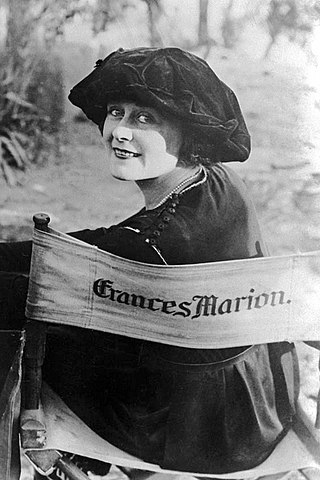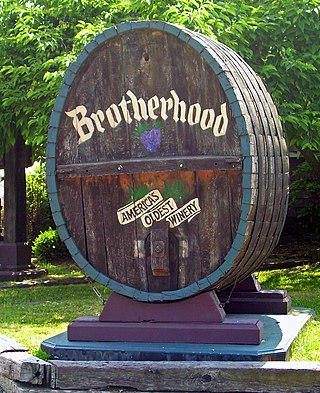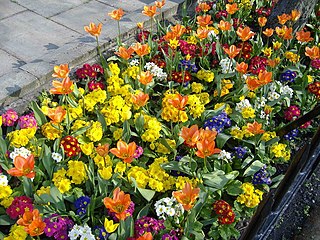
Dahlia is a genus of bushy, tuberous, herbaceous perennial plants native to Mexico and Central America. Dahlias are members of the Asteraceae family of dicotyledonous plants, its relatives include the sunflower, daisy, chrysanthemum, and zinnia. There are 49 species of dahlia, with flowers in almost every hue, with hybrids commonly grown as garden plants.

Tubers are a type of enlarged structure that plants use as storage organs for nutrients, derived from stems or roots. Tubers help plants perennate, provide energy and nutrients, and are a means of asexual reproduction.

Gavin Christopher Newsom is an American politician and businessman serving since 2019 as the 40th governor of California. A member of the Democratic Party, he served as the 49th lieutenant governor of California from 2011 to 2019 and the 42nd mayor of San Francisco from 2004 to 2011.

Wine Country is a region of California, in the northern San Francisco Bay Area, known worldwide as a premier wine-growing region. The region is famed for its wineries, its cuisine, Michelin star restaurants, boutique hotels, luxury resorts, historic architecture, and culture. Viticulture and wine-making have been practiced in the region since the Spanish missionaries from Mission San Francisco Solano established the first vineyards in 1812.

Frances Marion was an American screenwriter, director, journalist and author often cited as one of the most renowned female screenwriters of the 20th century alongside June Mathis and Anita Loos. During the course of her career, she wrote over 325 scripts. She was the first writer to win two Academy Awards. Marion began her film career working for filmmaker Lois Weber. She wrote numerous silent film scenarios for actress Mary Pickford, before transitioning to writing sound films.

USS Napa (APA-157) was a Haskell-class attack transport in service with the United States Navy from 1944 to 1946. She was scrapped in 1983.

The Napa Valley Opera House is a theatre in Napa, California, it opened on February 13, 1880, with a production of Gilbert and Sullivan's HMS Pinafore.

Katherine Olivia Sessions was an American botanist, horticulturalist, and landscape architect closely associated with San Diego, California. She is known as the "Mother of Balboa Park".

The wide variety of wild grapes in North America were eaten by the indigenous people. The first Europeans exploring parts of North America called it Vinland because of the profusion of grape vines found there. The various native grapes had flavors which were unfamiliar to European settlers and did not like using them in the initial production of American wine. This led to repeated efforts to grow familiar Vitis vinifera varieties. The first vines of Vitis vinifera origin came up through New Spain (Mexico) and were planted in Senecu in 1629, which is near the present day town of San Antonio, New Mexico.

Jennifer Lynn Siebel Newsom is an American documentary filmmaker and actress who is the first partner of California, as the wife of Governor Gavin Newsom. She is the director, writer, and producer of the film Miss Representation (2011), which premiered in the documentary competition at the Sundance Film Festival. The film examines how the media has underrepresented women in positions of power. The Mask You Live In (2015), the second film that she wrote, produced and directed, scrutinizes American society's definition of masculinity.

Many types of flowering plants are available to plant in flower gardens or flower beds. The floral industry calls these bedding plants. These fast-growing plants in seasonal flower beds create colourful displays, during spring, summer, fall or winter, depending on the climate. Plants used for bedding are generally annuals, but biennials, tender perennials, and succulents are also used.

Ornamental bulbous plants, often called ornamental bulbs or just bulbs in gardening and horticulture, are herbaceous perennials grown for ornamental purposes, which have underground or near ground storage organs. Botanists distinguish between true bulbs, corms, rhizomes, stem tubers and tuberous roots, any of which may be termed "bulbs" in horticulture. Bulb species usually lose their upper parts during adverse conditions such as summer drought and heat or winter cold. The bulb's storage organs contain moisture and nutrients that are used to survive these adverse conditions in a dormant state. When conditions become favourable the reserves sustain a new growth cycle. In addition, bulbs permit vegetative or asexual multiplication in these species. Ornamental bulbs are used in parks and gardens and as cut flowers.

Amorphophallus titanum, the titan arum, is a flowering plant in the family Araceae. It has the largest unbranched inflorescence in the world. The inflorescence of the talipot palm, Corypha umbraculifera, is larger, but it is branched rather than unbranched. A. titanum is endemic to rainforests on the Indonesian island of Sumatra.
Alfred D. Robinson (1866–1942) and his wife Marion James Robinson (1873–1919) were wealthy residents of San Diego, California, known for their impact on gardening and the cultivation of flowers, particularly begonias. Their extensive home garden was used to propagate and develop more than 100 new varieties of ornamental flowers and was later opened to the public as Rosecroft Begonia Gardens. Rosecroft was the name of their estate in the Point Loma neighborhood of San Diego. The residence, built for them in 1912, is now listed on the National Register of Historic Places.

Dahlia Hill (DH) is both a protected garden area in the Lower Peninsula of Michigan, encompassing 1.41 acres (0.57 ha) of terraced gardens, and the a 501(c)(3) non-profit educational organization that runs the garden. Located in the city of Midland, Michigan, they annually grow more than 3,000 dahlia plants.
Isabel Seal Stovel was one of organizers of the City of San Francisco Music Week.
Samuel Newsom was a Canadian-born American architect. Together with his brother Joseph Cather Newsom founded the architecture firm Newsom and Newsom, practicing in Northern and Southern California. Their most celebrated house is the Carson Mansion in Eureka, California.
The government of California initially responded to the COVID-19 pandemic in the state with a statewide lockdown, the first of its kind during the COVID-19 pandemic in the United States. As the pandemic progressed in California and throughout the rest of the country, the California government, following recommendations issued by the U.S. government regarding state and local government responses, began imposing social distancing measures and workplace hazard controls.
Buchli is an unincorporated community in Napa County, California. It lies at an elevation of 16 feet between Los Carneros AVA and the Napa-Sonoma Marsh, along the Brazos subdivision of the railway owned by Sonoma–Marin Area Rail Transit.
Vanessa Getty is an American socialite and philanthropist.
















